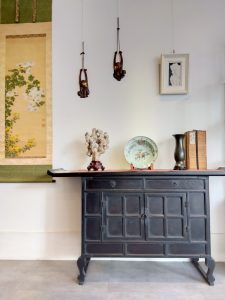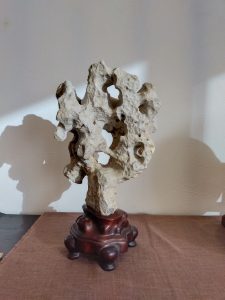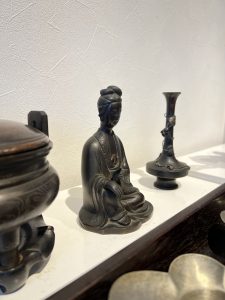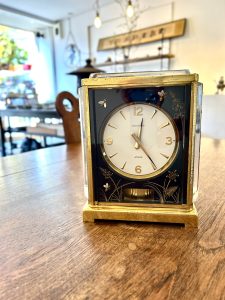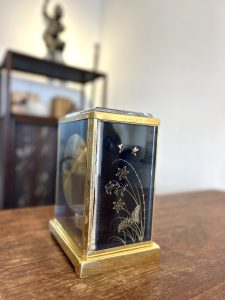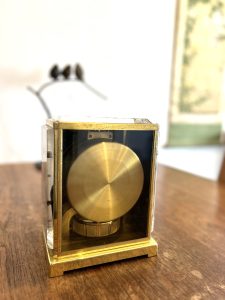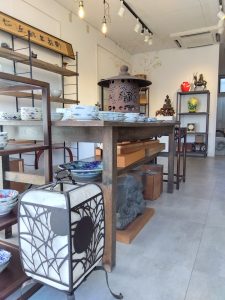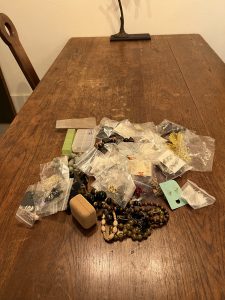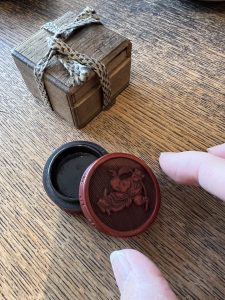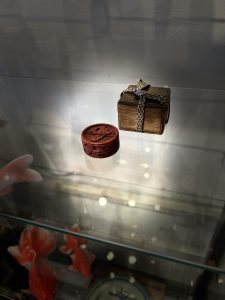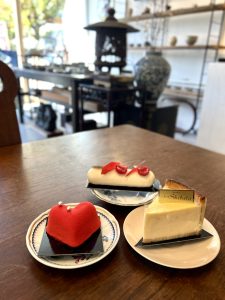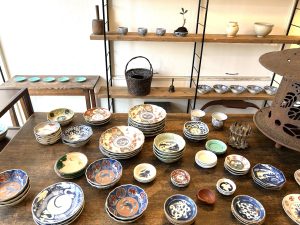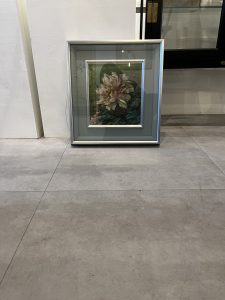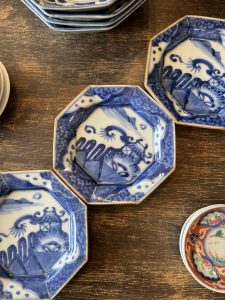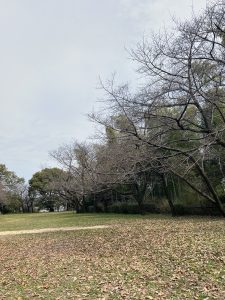自由でおおらかな魅力(愛知県名古屋市千種区姫池通 骨董買取 古美術風光舎)
2023.12.13
皆さまこんにちは。スタッフHでございます。
先日は久しぶりに雨の音を聞きながら眠りました。ざあざあ降りでも、小雨でも、なぜか落ち着いて熟睡できるのは私だけでしょうか?
さて、本日は存在感のある鳴海織部に向き合ってみました。自由奔放な雰囲気が好きなのですが、文章に書くとなると尻込みしていました。大らかすぎて手に負えない感じでしょうか。正面はどこ?としばらく悩みました。
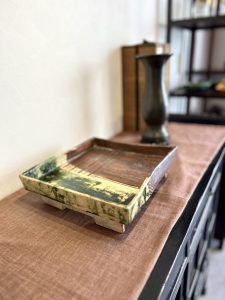
織部焼は安土桃山時代に美濃国(現在の岐阜県)で、武将でもあり茶人でもあった古田織部の好みによって焼成された陶器だと言われています。南蛮貿易が盛んに行われた桃山時代、中国南部で作られた「華南三彩」に対する憧れから織部焼の緑を生んだのではないかとも言われています。華南三彩の緑はムラのない均一な緑が特徴ですが、日本人は緑釉が流れたり、ムラのあるものを美しいと感じ、それを「けしき」として愛しました。
古田織部の師匠であった千利休は装飾をそぎ落としたシンプルな「わびさび」を感じる器を好んでいましたが、織部はほかの焼物にはない自由で豪快な形や奇抜な文様を好みました。
織部焼の暗緑色は釉薬に酸化銅を混ぜることにより生み出され、「青織部」として有名で、主に食器として使われています。「鬼板」と呼ばれる褐鉄鉱を粉にしたものや、白土などを溶いたものを筆に取り、のびのびと自由に文様が描かれています。
その他にも茶道における茶碗として使われる「織部黒」「黒織部」、赤土と白土を繫ぎ合わせ、幾何学模様が特徴の「鳴海織部」など様々な様式があります。織部焼の多様な形を可能にする技法のひとつとして「型打ち」があり、型を上に立ち上げれば花器、真っ平にすればタイル、小さくすれば豆皿など一つの型から様々な形が生まれます。織部焼の型を写し取ることででも現在でも当時の作り手たちのこだわりを感じることができるといいます。
織部焼を調べているうちに興味深い記述をみつけました。そもそもなぜ東海地方で焼き物が盛んに作られたかという考察です。名古屋市史によると、650万年前から100万年前、伊勢湾北部から濃尾平野に至る巨大な湖「東海湖」があり、最大で琵琶湖の6倍の大きさだったとのこと。地殻変動で湖は姿を消しましたが、湖の底に堆積していた火山灰が粘土状のものとなり、今の焼き物の原料となっているとか。世界最高の粘性を持つ白い粘土で他に類をみないそうです。
また東農地方はゆるやかな丘陵地帯が多く、桃山時代には登り窯と呼ばれる斜面に沿って作られた窯が用いられ、多くの素晴らしい作品が生み出されました。
様々な土地の恵みにより、生まれるべくして生まれた焼き物の産地だったのですね。
それでは、またお会いしましょう。

Hello everyone. This is Staff H.
The other night, for the first time in a while, I slept while listening to the sound of rain. Is it only me who can sleep calmly and soundly whether it is pouring or drizzling?
Well, today, I faced Oribe ware with a strong presence. I like the free and unrestrained atmosphere, but I had been shying away from writing about it. Is it too big-hearted and unruly? Where is the front? I was troubled for a while.
Oribe ware is said to be a pottery produced in the Azuchi-Momoyama period in Mino Province (present-day Gifu Prefecture) according to the taste of Oribe Furuta, who was both a military commander and a tea master. It is said that the green color of Oribe ware may have originated from his admiration for “Huanan Sansai,” a color produced in southern China during the Momoyama period, when trade with the southern barbarians was flourishing. The green of Huanan Sansai is characterized by a uniform green with no irregularities, but the Japanese found the flowing or uneven green glaze beautiful and loved it as “keshiki.
Sen no Rikyu, Oribe Furuta’s master, favored simple wabi-sabi (simplicity without decoration), while Oribe preferred free and bold shapes and eccentric patterns that were not found in other pottery.
The dark green color of Oribe ware is produced by mixing iron oxide into the glaze and is known as “blue Oribe,” and is mainly used as tableware. Oribe ware is also known for its use in the tea ceremony, where the design is freely and spontaneously drawn on the brush using powdered brown iron ore or dissolved white clay, called “oniita”.
There are also various other styles, such as “Oribe Black” and “Black Oribe” used as tea bowls in the tea ceremony, and “Narumi Oribe” characterized by geometric patterns merging red clay and white clay. One of the techniques that enable the various shapes of Oribe Pottery is “katauchi” (molding). Various shapes can be created from a single mold, such as a flower vase if the mold is raised up, a tile if it is flattened, and a bean dish if it is made small. By copying Oribe-yaki molds, one can still feel the attention to detail of the makers of the time.
While researching Oribe ware, I found an interesting description. It is a study of the reason why pottery was so popular in the Tokai region in the first place. According to the Nagoya City History, from 6.5 million to 1 million years ago, there was a huge lake called “Lake Tokai” stretching from the northern part of Ise Bay to the Nobi Plain, which was six times larger than Lake Biwa at the maximum. The lake disappeared due to tectonic movements, but the volcanic ash that accumulated at the bottom of the lake became clay-like and is used as a raw material for pottery today. It is said that this white clay has the highest viscosity in the world and is unique.
The Dongnong area has many gently sloping hills, and during the Momoyama period (1573-1600), the climbing kilns, which were built along the slopes, were used to produce many wonderful pieces of pottery.
The region was a production center of pottery that was born from the blessings of the land.
I hope to see you again soon.
*******************
ご実家の整理やお片付けなどをされている方のご相談などが多くございます。
お片付けなどくれぐれもご無理のないようになさってくださいませ。
風光舎では古美術品や骨董品の他にも絵画や宝石、趣味のお品など様々なジャンルのものを買受しております。
お片付けをされていて、こういうものでもいいのかしらと迷われているものでも、どうぞお気軽にご相談下さいませ。
また風光舎は、出張買取も強化しております。ご近所はもちろん、愛知県内、岐阜県、三重県その他の県へも出張いたします。
まずは、お電話お待ちしております。
愛知県名古屋市千種区姫池通
骨董 買取
【古美術 風光舎 名古屋店】
TEL052(734)8444
10:00-18:00 OPEN
#出張買取#骨董#古美術#骨董品#絵画#版画#茶道具#刀剣#彫刻

